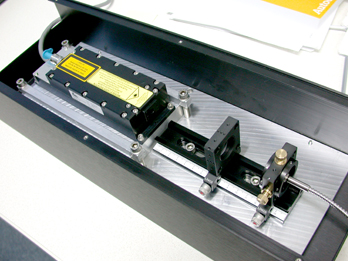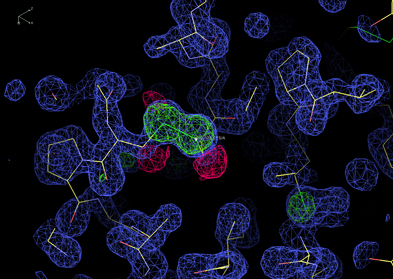Joint Research Group Macromolecular Crystallography
UV radiation damage-induced phasing (UVRIP)
The UVRIP method has been developed recently at EMBL-Grenoble by Raimond Ravelli and coworkers [1]. It is based on specific structural changes of cystines containing protein crystals, which is due to the irradiation with highly-intensive ultraviolet (UV) radiation. The structural changes can be used to work out a MIR-like phasing scheme [2], which can lead to precise experimental phase information. Therefore a native dataset is collected and compared with a dataset collected after the UV-irradiation of the same crystal.
We think that this method has a considerable potential as an alternative way of experimental phasing. However, due to the novelty of this method the success rate for UVRIP phasing for real-life proteins has to be determined. Thats why we are offering interested academic users the appliance of our UVRIP instrumentation and the assistance of our beamline support staff, who will provide support during the experiment as well as for the data evaluation.
Requirements
- Number of cystines per 100 amino acids: minimal 1-2
- Crystal size: 40-100µm longest edge
- High resolution diffraction limit for complete dataset: 2.3 Å or better
- Sample environment: Minimal cryo solution surrounding the crystal, small loop <0.2mm diameter, best would be freezing the crystal at the beamline
UVRIP setup
The experimental setup consists of a 266nm pulsed microship-laser (TEM photonics, SNP series), and a optical fibre coupling system (Figure 1) as well as a xyz-manual translation stage to position the quarz optical fibre towards the frozen crystal (Figure 2).
First results
Using the described setup, all used standard proteins (insulin, thaumatin, elastase) and one real-life protein could be successfully phased. An example of an UVRIP experimental map, with difference density of thaumatin is shown in Figure 3.
Application for UVRIP experimental beamtime
If you are intersted to perform an UVRIP experiment, send an e-mail to the contact person in the right box, describing your scientific case and the sample in answering the following questions:
- scientific background,
- number of aminoacids per molecule,
- number of cystines per molecule,
- maximum resolution of available dataset,
- Rsym, completeness, I/σ(I) for all data and high resolution shell of referenced dataset,
- availability of unfrozen crystals.
References
[1] Max H. Nanao and Raimond B. G. Ravelli, Phasing Macromolecular Structures with UV-Induced Structural Changes (2006), Structure 14, pp. 791-800
[2] Max H. Nanao, George M. Sheldrick and Raimond B. G. Ravelli, Improving radiation-damage substrucutres for RIP (2005), Acta Cryst. D61, pp. 1227-1237



